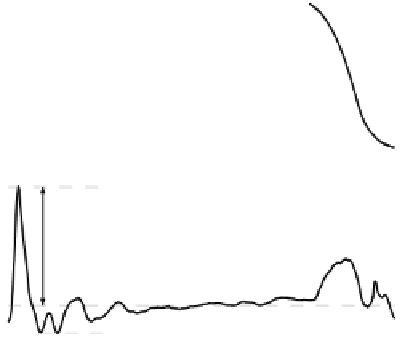Biomedical Engineering Reference
In-Depth Information
Fig. 5 a The vertical ground
reaction force signal GRF
z
in
bodyweights (BW), and b the
tibial axial acceleration a
z
over a normal gait cycle.
Definitions of the initial peak
acceleration (IPA) and peak-
to-peak acceleration (PP)
parameters are demonstrated
(a)
1
0
(b)
2
IPA
PP
1
0
0
20
40
60
80
100
Contact time (%)
because they provide reliable estimates of joint impulsive loading (e.g. initial peak
acceleration (IPA) and peak-to-peak (PP) acceleration) in a non-invasive manner
(Fig.
5
)[
29
,
30
].
We examined the effects of BMI in three BMI categories, normal weight
(BMI \ 25 kg/m
2
), overweight (25 B BMI \ 30 kg/m
2
), and obese (BMI C
30 kg/m
2
), on joint impulsive loading in level walking in men with knee OA and
healthy control subjects (Kuopio Knee OA Study) [
29
]. Fifty-three men with knee
OA (50-69 years) and 53 healthy age- and sex-matched controls were enrolled in
the study. The participants walked barefoot in the laboratory at a standardized
walking speed (1.2 m/s ± 5 %). Joint loading was assessed with Meac-x accel-
erometers (Mega Electronics Ltd, Kuopio, Finland) attached the medial surface of
the proximal tibia at 20 % of the distance between the medial malleolus and the
medial knee joint space (tibial plateau) [
30
]. The positive z axis a
z
(axial accel-
eration) of the sensor was aligned parallel to the straight limb. The analyzed SMA
parameters were axial IPA and PP acceleration (Fig.
5
)[
29
,
30
].
Our hypothesis was that because body accelerations are not dependent on body
mass, they should not therefore change if the gait pattern and velocity do not
change. However, the overall impression of the results was that the overweight and
obese subjects load their lower extremity more than lean individuals on initial
contact (Fig.
6
). Thus, we had to reject our initial hypothesis that BMI would
simply cause mass-driven adaptations in gait. Our finding may have clinical
importance in knee joint degeneration. Knee OA is a disorder in which excessive
impulsive forces in the knee joint have been claimed to serve as co-factors in its
initiation and progression [
2
,
6
,
45
]. We believe that increases in loadings could
unfavorably alter the mechanical and biochemical profiles of obese adults by
increasing cartilage and subchondral bone stress, provoking microtrauma and thus
increased triggering of local joint inflammation [
45
,
58
].


























































Search WWH ::

Custom Search